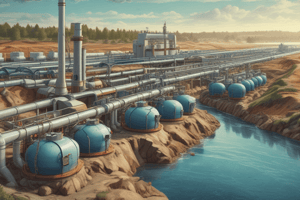Podcast
Questions and Answers
What is the primary function of sanitary sewer systems?
What is the primary function of sanitary sewer systems?
- Manage stormwater runoff effectively
- Treat wastewater before disposal
- Direct stormwater to nearby bodies of water
- Prevent leakage and spillage of wastewater (correct)
Which type of sewer system is responsible for managing stormwater runoff?
Which type of sewer system is responsible for managing stormwater runoff?
- Combined sewer systems
- Main sewer lines
- Sanitary sewer systems
- Stormwater sewer systems (correct)
Why do stormwater sewer systems not involve treatment of the water?
Why do stormwater sewer systems not involve treatment of the water?
- To reduce the workload on treatment plants
- To prevent contamination of nearby water sources (correct)
- To speed up the disposal process
- To save costs in the sewer system infrastructure
What are the main components of a sanitary sewer system?
What are the main components of a sanitary sewer system?
What distinguishes stormwater sewer systems from sanitary sewer systems?
What distinguishes stormwater sewer systems from sanitary sewer systems?
Why is it essential for sanitary sewer systems to avoid leakage or spillage of wastewater?
Why is it essential for sanitary sewer systems to avoid leakage or spillage of wastewater?
What are the two main stages involved in water treatment?
What are the two main stages involved in water treatment?
Which type of treatment involves physical processes like screening and sedimentation?
Which type of treatment involves physical processes like screening and sedimentation?
What is the purpose of bar screens in wastewater treatment?
What is the purpose of bar screens in wastewater treatment?
What challenges are associated with combined sewer systems?
What challenges are associated with combined sewer systems?
What is the purpose of tertiary treatment in wastewater treatment?
What is the purpose of tertiary treatment in wastewater treatment?
Which method is employed in secondary treatment to reduce the amount of biodegradable material in the effluent?
Which method is employed in secondary treatment to reduce the amount of biodegradable material in the effluent?
Flashcards are hidden until you start studying
Study Notes
Sewer Systems and Water Treatment: Ensuring Clean Waterways and Safe Drinking Supplies
Introduction
Sewer systems and water treatment play essential roles in maintaining public health and protecting the environment. These systems aim to collect, treat, and dispose of wastewater effectively, ensuring that it does not pose a threat to human health or the natural world. This article explores the intricacies of sewer systems and the importance of water treatment in achieving this goal.
Sewer Systems
There are three main types of sewer systems: sanitary, stormwater, and combined. Each serves a unique purpose in managing wastewater and preventing environmental degradation.
Sanitary Sewer Systems
Sanitary sewer systems are responsible for carrying wastewater from homes and businesses to wastewater treatment plants. They consist of laterals attached to buildings, main sewer lines, manholes, and wastewater treatment facilities. Their primary function is to ensure that wastewater reaches treatment plants without leakage or spillage, which can contaminate groundwater and nearby water sources.
Stormwater Sewer Systems
Stormwater sewer systems are designed to manage stormwater runoff from rainfall, snowmelt, and other precipitation events. Unlike sanitary sewer systems, stormwater systems do not involve treatment; instead, they guide stormwater directly to nearby bodies of water, such as creeks, streams, rivers, lakes, or ponds, often part of a local drinking water system.
Combined Sewer Systems
Combined sewer systems integrate sewer and stormwater systems into a single infrastructure. However, these systems are now rarely used due to their high cost and challenges associated with managing combined sewer overflows (CSOs) during heavy rainfall.
Water Treatment
Water treatment plays a crucial role in safeguarding public health and preserving the environment by eliminating contaminants from wastewater before it can be returned to the environment. The process typically entails two main stages: primary treatment and secondary treatment. Advanced treatment methods, such as tertiary treatment, may also be employed to enhance the effectiveness of the system.
Primary Treatment
Primary treatment involves physical processes, such as screening and sedimentation, to remove solid materials and suspended solids from wastewater. Bar screens help to remove large particles, while grit chambers facilitate the separation of sand and silt.
Secondary Treatment
Secondary treatment employs biological processes, such as the activated sludge method, to break down organic matter present in wastewater. This step significantly reduces the amount of biodegradable material in the effluent.
Tertiary Treatment (Advanced Treatment)
In some instances, additional processes known as tertiary treatment or quaternary treatment are incorporated to further refine the wastewater treatment process. Tertiary treatment includes polishing processes and nutrient removal, ensuring that the final product meets stringent environmental and public health standards.
By implementing robust sewer systems and efficient water treatment strategies, we can protect our water resources, reduce health risks, and promote sustainable growth in our communities.
Studying That Suits You
Use AI to generate personalized quizzes and flashcards to suit your learning preferences.




